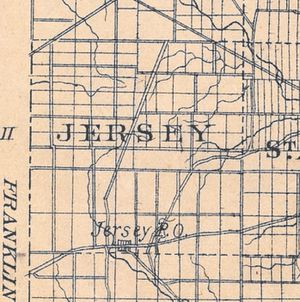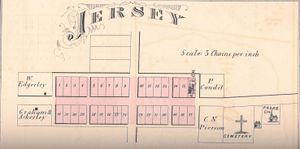Difference between revisions of "Jersey Township"
| (6 intermediate revisions by the same user not shown) | |||
| Line 1: | Line 1: | ||
| − | [[File:Jersey township hills 1881.jpg|thumb|Image of Jersey Township from larger map of Licking County found in Hill's History of Licking County from 1881.]]Jersey | + | [[File:Jersey township hills 1881.jpg|thumb|Image of Jersey Township from larger map of Licking County found in Hill's History of Licking County from 1881.]]Jersey Township—located on the western edge of the county—is bounded by [[Monroe Township]] to the north, [[St. Albans Township]] to the east, [[Pataskala Township]] to the south, and Franklin County to the west. |
| − | The topography of Jersey Township is marked by gentle rises and falls in elevation | + | The topography of Jersey Township is marked by gentle rises and falls in elevation with a general downward slope toward the south. Several creeks, including the Black Lick and a fork of the Licking, have their origins in the township. Heavily forested terrain gave way to cultivation as the land was cleared in the nineteenth century. <ref> Hill, N., ''History of Licking County'', (1881), 482 </ref> |
| − | Jersey Township possessed a handful of prehistoric structures. <ref> Mill, W. Archaeological Atlas of Ohio, (1914), 45-46 </ref> When non-indigenous settlers first arrived in the area, they came across recently abandoned dwellings believed to have belonged to the Wyandotte. These new settlers to Jersey Township—Joseph Headley, Peter Headley, and an unnamed Black man—arrived in 1815. The Headleys had come to the area from New Jersey | + | Jersey Township possessed a handful of prehistoric structures. <ref> Mill, W., ''Archaeological Atlas of Ohio'', (1914), 45-46 </ref> When non-indigenous settlers first arrived in the area, they came across recently abandoned dwellings believed to have belonged to the Wyandotte. These new settlers to Jersey Township—Joseph Headley, Peter Headley, and an unnamed Black man—arrived in 1815. The Headleys had come to the area from New Jersey after a brief stop in Muskingum County. They were joined by several other families that had emigrated west from New Jersey, and their purchase of land and construction of farms would provide the namesake for the township when it was organized in 1820. The origins of Jersey's third original settler, the unnamed Black man, are unknown. The township was first organized in 1820 by subdividing St. Albans Township. <ref> Hill, N., ''History of Licking County'', (1881), 482-483 </ref> |
=="Ghost Towns"== | =="Ghost Towns"== | ||
| − | Jersey Township possessed several ephemeral settlements: Ash Store, Ashbrook, Beech, Millers Corners, Panhandle Corners, Parkhurst Corners, and Jersey. <ref> Ohio Ghost Towns: No 44 Licking County, ed. Helwig and Helwig, (1998), 14-24 </ref> Most of these small settlements never expanded beyond a crossroads store and post office | + | Jersey Township possessed several ephemeral settlements: Ash Store, Ashbrook, Beech, Millers Corners, Panhandle Corners, Parkhurst Corners, and Jersey. <ref> ''Ohio Ghost Towns: No 44 Licking County'', ed. Helwig and Helwig, (1998), 14-24 </ref> Most of these small settlements never expanded beyond a crossroads store and post office, but even these developments proved transitory. |
==Jersey== | ==Jersey== | ||
| − | In 1832, a group of the | + | [[File:Jersey 1875 atlas.jpg|thumb|Detail of the village of Jersey found in the 1875 Atlas of Licking County.]] In 1832, a group of the township's early settlers came together to found the only settlement in the township, also named [[Jersey]]. A post office followed though some sources indicate that a post office led to the establishment of a village. <ref> see Hill, N. ''History of Licking County'', (1881), 484, for a post office date of 1830 and ''Ohio Ghost Towns: No 44 Licking County'', ed. Helwig and Helwig, (1998), 106 for the 1833 date. </ref> Several businesses-including a mill-were built at Jersey, and a cluster of houses with accompanying churches were built around them. The village still stands at the intersection of Morse Road with Condit Drive and Headleys Mill Road. <ref> ''Ohio Ghost Towns: No 44 Licking County'', ed. Helwig and Helwig, (1998), 106 </ref> |
| + | |||
| + | Like many traditionally rural and agricultural areas of Licking County, Jersey Township has experienced population growth and commercial development in the first two decades of the twenty-first century, as the suburbs of Columbus—specifically New Albany for Jersey Township—expand eastward. | ||
| + | |||
| + | In January 2022, Intel announced that it would construct a new computer chip manufacturing site in a section of Jersey Township that would be annexed into New Albany. Construction on the $20 billion project should begin in 2022 with the factories producing chips by 2025. <ref> "Jersey Township announces planning initiative after $20 billion Intel announcement," Newark Advocate, Jan. 21, 2022 </ref> | ||
| + | |||
| + | '''J.G.''' | ||
| + | |||
| − | |||
Return to [[Townships and Communities]] main page. | Return to [[Townships and Communities]] main page. | ||
==References== | ==References== | ||
Latest revision as of 12:08, 7 February 2022
The topography of Jersey Township is marked by gentle rises and falls in elevation with a general downward slope toward the south. Several creeks, including the Black Lick and a fork of the Licking, have their origins in the township. Heavily forested terrain gave way to cultivation as the land was cleared in the nineteenth century. [1]
Jersey Township possessed a handful of prehistoric structures. [2] When non-indigenous settlers first arrived in the area, they came across recently abandoned dwellings believed to have belonged to the Wyandotte. These new settlers to Jersey Township—Joseph Headley, Peter Headley, and an unnamed Black man—arrived in 1815. The Headleys had come to the area from New Jersey after a brief stop in Muskingum County. They were joined by several other families that had emigrated west from New Jersey, and their purchase of land and construction of farms would provide the namesake for the township when it was organized in 1820. The origins of Jersey's third original settler, the unnamed Black man, are unknown. The township was first organized in 1820 by subdividing St. Albans Township. [3]
"Ghost Towns"
Jersey Township possessed several ephemeral settlements: Ash Store, Ashbrook, Beech, Millers Corners, Panhandle Corners, Parkhurst Corners, and Jersey. [4] Most of these small settlements never expanded beyond a crossroads store and post office, but even these developments proved transitory.
Jersey
In 1832, a group of the township's early settlers came together to found the only settlement in the township, also named Jersey. A post office followed though some sources indicate that a post office led to the establishment of a village. [5] Several businesses-including a mill-were built at Jersey, and a cluster of houses with accompanying churches were built around them. The village still stands at the intersection of Morse Road with Condit Drive and Headleys Mill Road. [6]Like many traditionally rural and agricultural areas of Licking County, Jersey Township has experienced population growth and commercial development in the first two decades of the twenty-first century, as the suburbs of Columbus—specifically New Albany for Jersey Township—expand eastward.
In January 2022, Intel announced that it would construct a new computer chip manufacturing site in a section of Jersey Township that would be annexed into New Albany. Construction on the $20 billion project should begin in 2022 with the factories producing chips by 2025. [7]
J.G.
Return to Townships and Communities main page.
References
- ↑ Hill, N., History of Licking County, (1881), 482
- ↑ Mill, W., Archaeological Atlas of Ohio, (1914), 45-46
- ↑ Hill, N., History of Licking County, (1881), 482-483
- ↑ Ohio Ghost Towns: No 44 Licking County, ed. Helwig and Helwig, (1998), 14-24
- ↑ see Hill, N. History of Licking County, (1881), 484, for a post office date of 1830 and Ohio Ghost Towns: No 44 Licking County, ed. Helwig and Helwig, (1998), 106 for the 1833 date.
- ↑ Ohio Ghost Towns: No 44 Licking County, ed. Helwig and Helwig, (1998), 106
- ↑ "Jersey Township announces planning initiative after $20 billion Intel announcement," Newark Advocate, Jan. 21, 2022

